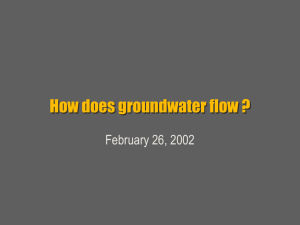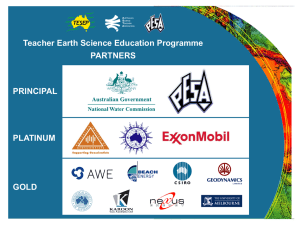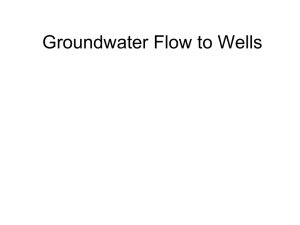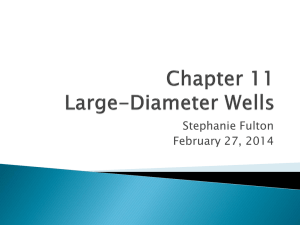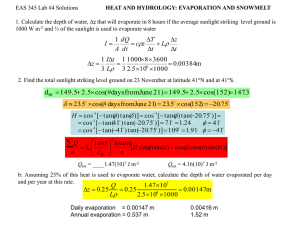Pilot Project on Aquifer Mapping
advertisement
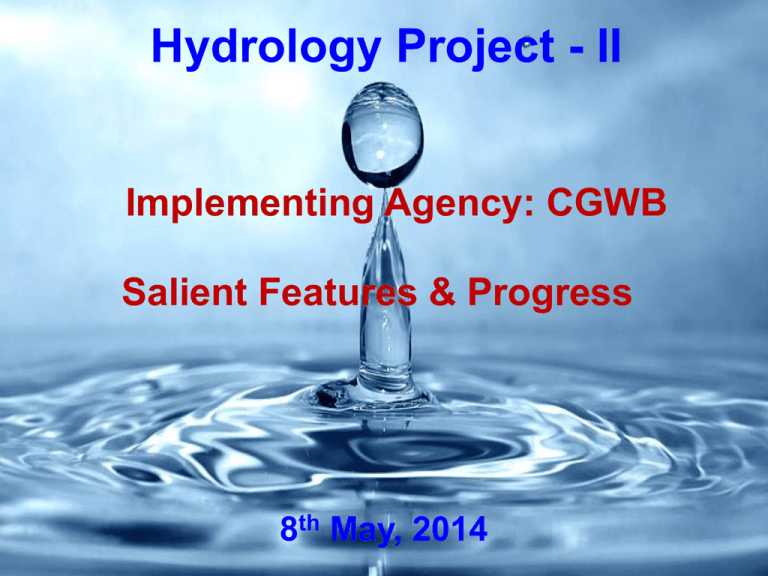
Hydrology Project - II Implementing Agency: CGWB Salient Features & Progress 8th May, 2014 Items Cost Project Cost (CGWB) As per Original PIP – Rs 27.95 Crore As per RCT 2013 - Rs 66.32 Crore Expenditure Incurred upto 38.45 Crore March, 2014 Likely Expenditure by May 31, 2014 (allotted-2.02 Cr, Addl.fund 13.19 Crore sought – 11.17 Cr) Reimbursement 32.27 Crore 13.28 Crore Total under HP Likely Spill Over 51.64 Crore 45.55 Crore eGEMS 15.97 Crore Dev- 1.52 Crore SW /HW- 14.45 Crore Pilot project on Aquifer Mapping 0.89 Crore 10% of consultancy Total Spill over 16.86 Crore Name of Activities/Program Achievements Upgrading of Hardware 19 Server and 59 workstation procured Hardware procured (Pilot Aquifer Mapping) Software procured Data Procured i) Work Station -12 Nos ii) Laser Printer- 5Nos iii) Note Book- 14Nos iv) Scanner - 5 Nos. ERDAS Imagine, Arc GIS, Rockworks Aquifer Test Pro for Pilot Aquifer Mapping Visual Modflow, Aquifer Test Pro, Modflow Surfact, Hydrogeoanalyst, GMS V 8.1, FEFLOW FMH3 & Temporal Analyst for Ground Water Modeling Centre All India GIS digital data set at Village Boundary Level Digital Toposheets for Pilot Aquifer Mapping Areas The DSS for the water resources planning developed Decision Support System (DSS) by NIH, Roorkee and technical feedback provided by CGWB with respect to GW component. Name of Activities/Program Achievements Awareness Raising Training 32 Training on Domain & Software 27 International Training and Study Tour Officers of CGWB deputed for 8 International Training courses Purpose Driven Study 1)Specific Yield Study for Planning and Designing AR Structures in Sub-urban in Chennai – Completed. 2)Real Time Ground Water Monitoring System in NCT, Delhi – Procurement of DWLR (30 nos.) with Telemetry System not materialised. However, the study has been completed using manual measurement 3)Pilot project on Aquifer Mapping- Continuing Construction of Piezometers 114 (Punjab-65, Goa-49) Construction of Wells 35 - under Chennai PDS 76 – Under Pilot Project on Aquifer Mapping Analytical Quality Control Exercise Name of Activities/Program Achievements Award Date (Consultancy for development of e-GEMS) 06.11.12 Start Date End Date 20.11.12 19.11.13 Extension of Consultancy Progress Procurement of Software Extension sought from Ministry upto 31 May, 2014 after getting approval of HLTG Members Revised Project Plan • Data Entry modules developed • Few Reports and Charts developed • Software development in progress • The proposal for procurement of Arc GIS is being sent to PCS, MoWR for financial sanction • Tender for procurement of Oracle, SAP & Visual Studio under preparation Name of Activities/Program Achievements • Proposal for hiring of BSNL Data Centre services for hosting of e-GEMS is under Procurement of Hardware submission • The cost of the proposal is Rs 13.36 Crore • Out of this 0.247 Crore is proposed from HP-II and 13.113 Crore from GWM&R Scheme Name of Study Major Findings The artificial recharge structure suitable for the region is the percolation pond with injection Specific Yield Study for Planning wells. Injection wells can be constructed inside and Designing AR Structures in the tanks to a depth of 13 to 20 mbgl. The top of Sub-urban in Chennai the injection well should be kept at the flood point level of the tanks. Under the study it was proposed to install Study of Ground Water automatic Data Logger on Piezometer at Dynamics and Installation of selected locations. But the procurement of data Real Time Ground Water logger could not be materialized due to certain Monitoring System in NCT, Delhi reasons beyond control. However, the study has been completed using manual measurement Pilot Project on Aquifer Mapping was taken up under Purpose Driven Study component in six different Hydrogeological terrains of the country. Pilot Project Areas Km2 Baswa-Bandikui Watershed, 598 Dausa District, Rajasthan - I – AQRAJ Maner-Khagaul Area, Patna Dist, 521 Bihar (Watershed GNDK013) - II – AQBHR Watershed WGKKC-2, Nagpur 360 district, Maharashtra - III – AQMAH Parts of Tumkur District, 376 Karnataka - IV – AQKAR Lower Vellar, Cuddalore district, 344 Tamil Nadu - V – AQTND Part of Thar Desert, Jaisalmar District, Rajasthan. - VI – AQDRT 675 • • • • Collection and Compilation of existing data completed. Various thematic layers prepared. Identification of data gap completed. Additional data generated using hydrogeological and geophysical techniques to fill the data gap. Water Level Data Water Quality Data Ground Water Exploration data through drilling Determination of Aquifer parameters through Pumping test Generation of Geophysical Data using Ground and Heliborne survey through NGRI as consultant • The integration of geophysical & hydrogeological data is under progress. • On the basis of hydrogeological data, conceptualization of aquifer system has been made for all pilot areas. Modeling through simulation is under progress. Activity Target Achievement Pre-SkyTEM 1D Surface Geophysics Post SkyTEM TOTAL VES 540 165 83 248 GTEM 115 222 162 384 Sub-Surface Geophysics Logging 120 10 17 27 2D Surface Geophysics ERT 75 51.72 40.04 91.76 HRSS 0.0 0.0 4.3 4.30 TEM 13800 Heliborne Geophysics SkyTEM 13860 • 2D & 3D aquifer disposition have been envisaged on the basis of Conceptual model. Different Aquifer systems have been demarcated. Bihar – Three Aquifers delineated and Palaeochannel have been characterized. Maharashtra - The zones of each flow depicting intertrappean, weathered and compact basalt could be identified and Gondwanas & Basalts have been precisely demarcated. Tamil Nadu - Four aquifer systems have been clearly indicated in Pilot area of Tamil Nadu; Palaeochannel showing fresh water aquifer comprising of coarse sand is seen at the depth of 100-110 m running N-S and occurrence of limestone at shallow depth along the coast at places may indicate fault. Karnataka - Potential zones identified at select locations. • The project is under progress and integration of results would bring out the refinement in sub surface disposition of aquifer; the efficacy of different techniques and protocol for use of Geophysical methods. Aquifer- I Aquifer- II Silty clay clayey sand Rock fragments with clay: light pale to pinkish brown fragments of quartzite, quartz and some ferro-magnesium minerals with little clay. Quartzite Bed Rock: light pale to dark brown colour chips of micaceous quartzite. -10 Elevation, m -10 -20 -20 -20 -20 400 100 -30 Elevation, m -30 -40 400 -40 -40 100 -50 -50 225 200 175 150 125 100 75 50 25 0 -40 DT7 DT6 -10 -20 1 Ohm-m -40 -50 225 200 175 150 125 100 75 50 25 0 400 Ohm-m -80 100 -60 Elevation, m -80 225 200 175 150 125 100 75 50 25 0 Elevation, m 10-60 -70 100 -20 -80 -20 -30 10 100 -40 1 Ohm-m -40 -50 -70 225 200 175 150 125 100 75 50 25 0 400 -20 400 400 1 -60 Ohm-m -140 225 200 175 150 125 100 75 50 25 0 100 10 -80 10 -100 1 -100 10 10 -120 400 100-60 -80 100 -100 -100 400-40 10 -60 -60 DT9 0 -10 -30 10 DT8 0 0 0 Elevation, m DT5 0 Elevation, m DT4 0 Elevation, m DT2 0 Elevation, m DT1 0 -120 225 200 175 150 125 100 75 50 25 0 -120 -140 1 225 200 175 150 125 100 75 50 25 0 Ohm-m 1 -120 225 200 175 150 125 75 50 25 0 Ohm-m 100 0.1 Ohm-m 1 Ohm-m Figure 12: TEM sounding results at AQDRT area Dray sand underlain by saline zone Marly Limestone with bentonite gypseous clay Saturated saline water alluvium underlain by limestone/s andstone 45,000 Neyveli Lignite Mine GPM pumping Perumal Eri • First Layer (Sandstone) Second Layer (Clay) Layer Fourth (Clay & Lignite) First Sea Layer (Bay of Bengal) ( Aquifer - I (Sandston e) (aquifer unit wise) (lower Vellar water shed, TN) Aquifer Issues I - Aquifer o Pumping for irrigation, II- Aquifer o Pumping for irrigation, IIIAquifer o Heavy withdrawal for Aquifer – II (sandstone) Aquifer - III (Sandstone) basement Aquifer Management Plan Aquifer – IVSixth layer (Sandstone)(Clay) Industries & Domestic. o Sea water intrusion Industries & Domestic. o Sea water intrusion Lignite mining (45,000 GPM) o Sea water intrusion Aquifer Management I - Aquifer Desilting of Perumal Eri (will induce recharge) II - Aquifer Managed Aquifer Recharge III - Aquifer Planned Pumping schedule & Managed Aquifer Recharge, after completion of mining IV - Aquifer Future allocation for drinking purposes Item Consultancy Charges Heliborne Survey Services Equipment cost Total Amount as per Contract Agreement Paid to NGRI up to 31.04.14 8,98,04,000 6,28,62,800 Payment to Aarhus University for Heliborne Survey 12,24,00,000 (70% = 10%+20%+40%) 6,76,19,558 (2,93,50,000 +3,82,69,558) (80% paid – 3 installment out of 4) Payment for Hiring of Helicopter Services 175,83,260 (first four areas-AQRAJ, AQDRT, AQMAH & AQBHR) 6,18,50,000 1,03,87,434 27,40,54,000 15,84,53,052 Head Activity Contracted Expenditur Likely Head Wise BE 2014- Requirement value/ e incurred expenditure to Total (Rs. 15 (Rs. in of Additional Estimated Cost by March be incurred by in Lakhs) Lakhs) Fund (Rs. in (Rs. in Lakhs) 31, 2014 May 31, 2014 Lakhs) (Rs. in (Rs. in Lakhs) Lakhs) NGRI Consultancy charges PS M&E 898.04 628.63 269.42 864.07 676.20 187.87 230.44 175.83 63.40 253.74 24.60 49.21 1336.00 0.00 48.40 Multi-Electrode Multi Channel Resistivity Systems (NGRI) 194.72 0.00 192.02 Advanced Resistivity Meters (NGRI) 39.22 28.29 9.59 Syscal Pro (by NGRI) 45.50 34.08 8.52 DGPS (by NGRI) 18.72 12.57 3.15 Server & Workstation-Payment Software for e-GEMS 86.86 331.00 82.08 0.00 3.78 255.62 394.60 128.61 - Heliborne Survey Services (Payment to Aarhus University by NGRI) Hiring of Helicopter Services (by NGRI) Consultancy for Development of eGEMS Hiring of BSNL services for Hosting of e-GEMS Major Construction of wells through Works outsourcing under Pilot Project FTE Foreign Training Total 618.30 192.00 426.30 472.68 0.00 472.68 265.99 265.99 0.00 265.99 - 10.00 10.00 10.00 0.00 1790.89 1366.97 1366.97 202.00 1164.97 From the experience of the scheme, following suggestions are made • Since the HP-I and HP-II was not implemented in few states, there is a need of upscaling the three major components of HP-II through strengthening of State Ground Water departments by improving of institutional and organisational arrangements 1. Introduction of e-GEMS to non-HP states on mutual consent of respective state governments 2. Development of Standard protocol for use of geophysical techniques for aquifer mapping from the results of Pilot Project on Aquifer Mapping, which will be used for National Aquifer Mapping programme. 3. Transfer and dissemination of hydrological and water quality data for basic water resource evaluations between central and all the state agencies Application of HIS: Following reports have been published using HIS data: State Report - Regional Groundwater Scenario depicting the occurrence, development potential and management options for groundwater resources of the state District report - Groundwater Scenario & formulation of sustainable groundwater development Strategy at the district level Ground Water Year Books - Groundwater Year Book for each region & Groundwater Year Book consolidated for the country are published every year Groundwater Estimation Report as in 2004, 2009 & 2011 by each States Assessment of Groundwater resources for each state Water Supply Investigation report - Feasibility report for sustainable groundwater development Groundwater Exploration Report - Summary of exploration carried out by Central Ground Water Board In addition, application of HIS data in Artificial Recharge Scheme formulation and water quality investigations. Data Dissemination: Data disseminated to various Central and State government departments, Central & state universities and research students for different academics and scientific investigations. A Journey from Ground Water Development to Aquifer Management Thanks Pilot Project on Aquifer Mapping HP III Proposed Activity for Hydrology Project III • Up-scaling to Other States (A) Institutional Strengthening • Procurement of Hydrogeological equipment • Procurements of Geophysical equipment • Procurement of software • Procurement of chemical equipment: (B) Vertical Extension • Identification of the issues related to public concern in water management in the existing states. • Hydro-geological support data collection at micro level • increased frequency of water level monitoring • Compilation and Integration of existing data HP III

